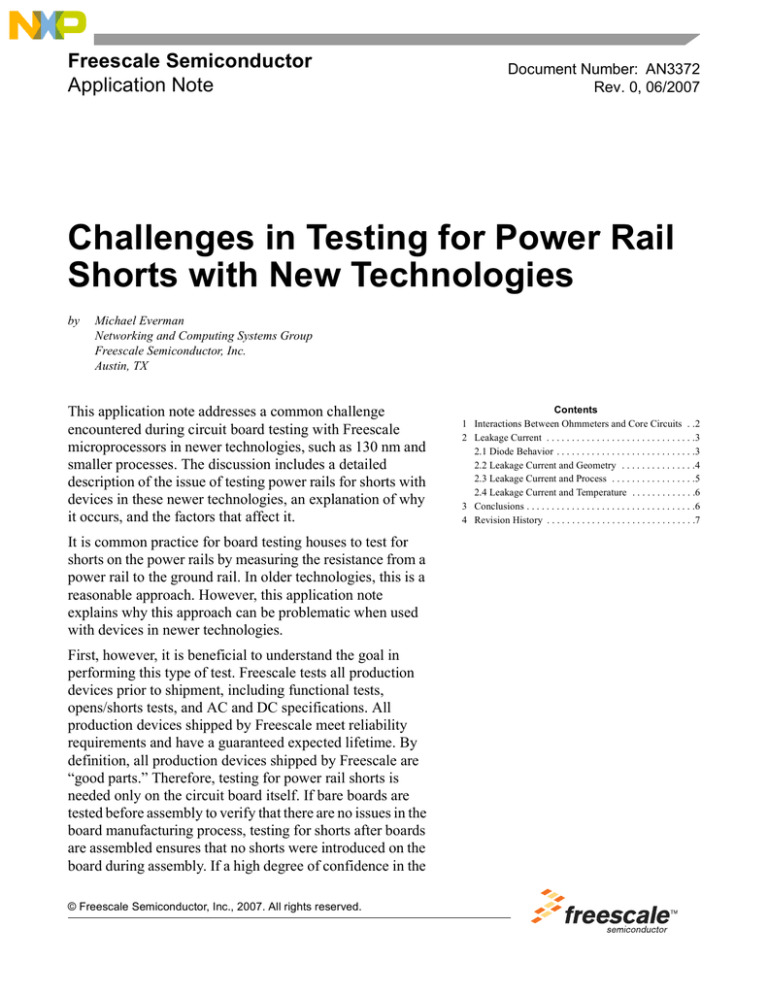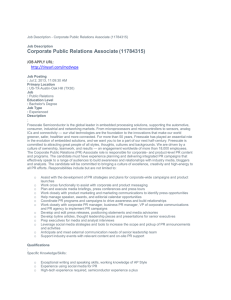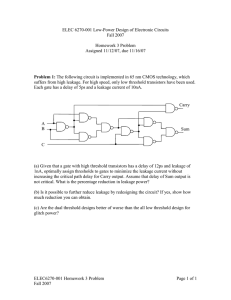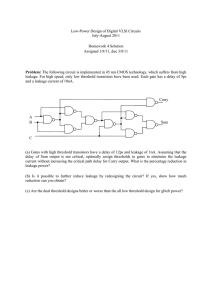
Freescale Semiconductor
Application Note
Document Number: AN3372
Rev. 0, 06/2007
Challenges in Testing for Power Rail
Shorts with New Technologies
by
Michael Everman
Networking and Computing Systems Group
Freescale Semiconductor, Inc.
Austin, TX
This application note addresses a common challenge
encountered during circuit board testing with Freescale
microprocessors in newer technologies, such as 130 nm and
smaller processes. The discussion includes a detailed
description of the issue of testing power rails for shorts with
devices in these newer technologies, an explanation of why
it occurs, and the factors that affect it.
It is common practice for board testing houses to test for
shorts on the power rails by measuring the resistance from a
power rail to the ground rail. In older technologies, this is a
reasonable approach. However, this application note
explains why this approach can be problematic when used
with devices in newer technologies.
First, however, it is beneficial to understand the goal in
performing this type of test. Freescale tests all production
devices prior to shipment, including functional tests,
opens/shorts tests, and AC and DC specifications. All
production devices shipped by Freescale meet reliability
requirements and have a guaranteed expected lifetime. By
definition, all production devices shipped by Freescale are
“good parts.” Therefore, testing for power rail shorts is
needed only on the circuit board itself. If bare boards are
tested before assembly to verify that there are no issues in the
board manufacturing process, testing for shorts after boards
are assembled ensures that no shorts were introduced on the
board during assembly. If a high degree of confidence in the
© Freescale Semiconductor, Inc., 2007. All rights reserved.
Contents
1 Interactions Between Ohmmeters and Core Circuits . .2
2 Leakage Current . . . . . . . . . . . . . . . . . . . . . . . . . . . . . .3
2.1 Diode Behavior . . . . . . . . . . . . . . . . . . . . . . . . . . . .3
2.2 Leakage Current and Geometry . . . . . . . . . . . . . . .4
2.3 Leakage Current and Process . . . . . . . . . . . . . . . . .5
2.4 Leakage Current and Temperature . . . . . . . . . . . . .6
3 Conclusions . . . . . . . . . . . . . . . . . . . . . . . . . . . . . . . . . .6
4 Revision History . . . . . . . . . . . . . . . . . . . . . . . . . . . . . .7
Interactions Between Ohmmeters and Core Circuits
assembly process exists, or if other testing procedures provide similar coverage, this test can be bypassed.
Note that devices shipped prior to achieving production status have limited guarantees and are covered
separately under Freescale SOP. If further information is needed, contact your sales representative.
1
Interactions Between Ohmmeters and Core Circuits
As stated previously, testing for shorts on a power rail by measuring the resistance from the power plane
to the ground plane with the board unpowered does not work well for devices in newer wafer technologies
such as 130 nm and smaller processes. It is particularly challenging with respect to the VDD (processor
core) power plane due to the number of circuits powered by this plane. This can be understood by
examining the core circuits and how the ohmmeter interacts with them. Figure 1 shows a typical core
circuit, a 2-input NAND gate. This is a simple circuit, but all core circuits are essentially variations on the
theme of totem-pole MOSFETs. The important thing to note is that the circuit consists only of
semiconductor transistors. There are no passive components such as resistors. These exist only as parasitic
effects of the transistors.
VDD
OUT
A
B
GND
Figure 1. Example Core Circuit: 2-input NAND Gate
Ideally, these transistors are perfect switches and conduct no current in the OFF state. Because the top and
bottom FETs are never on at the same time, ideally there is infinite resistance between VDD and GND. In
reality, parasitic diode effects cause current to leak through a FET even in the OFF state. The simplest way
to think of leakage current is to think of a CMOS FET in the OFF state as a reversed-biased diode, as shown
in Figure 2. The diode is a parasitic effect inherent to the p-n junctions in the transistors. These
reverse-biased diodes leak current whenever the core circuits are powered.
VDD
OUT
A
B
GND
Figure 2. Core Circuit with Parasitic Diodes
Challenges in Testing for Power Rail Shorts with New Technologies, Rev. 0
2
Freescale Semiconductor
Leakage Current
The next step is to understand how these core circuits will interact with an ohmmeter when one attempts
to measure the resistance from the VDD power plane to the GND plane. To measure resistance, the
ohmmeter applies a small voltage (typically in the millivolts) across the probes. The meter then measures
the current, converts the reading, and displays ohms, as shown in Figure 3. That is, the meter measures the
amount of current flowing from VDD to GND. In this circuit, the meter acts as a power supply to the core
and powers the transistors (albeit weakly). However, the only current flowing from VDD to GND is leakage
current through the parasitic diodes. Therefore, the meter is not measuring resistance at all—it is
measuring leakage current.
VDD
Ohmmeter
+
Supply
OUT
Measure
A
M(I)
Convert
and Display
B
—
10 Ω
GND
Figure 3. Ohmmeter and Core Circuit, with Leakage Current
2
Leakage Current
One obvious question that arises from the preceding section is whether the test is still valid, regardless of
whether the ohmmeter is measuring resistance or leakage current. This section examines the various
factors that affect leakage current and why its behavior with respect to these parameters makes this type
of test difficult to perform with consistent results on devices in newer technologies.
2.1
Diode Behavior
Because the ohmmeter in the previous example is shown to be measuring leakage current, it is necessary
to understand what factors affect it. The transistors in this case behave like reverse-biased diodes, so their
behavior is described by the reverse diode equation, as follows:
irev = irev_sat (eqV/kT — 1)
Where:
irev = reverse (leakage) current (A)
irev_sat = reverse saturation current (A)
q = charge of an electron (1.6 x 10-19 C)
V = reverse voltage, VDD (V)
k = Boltzman’s constant (1.38 x 10-23 J/K)
T = temperature (K)
Challenges in Testing for Power Rail Shorts with New Technologies, Rev. 0
Freescale Semiconductor
3
Leakage Current
The reverse saturation current is a function of process parameters (such as doping), device (p-n junction)
geometries, and temperature. Similarly, the effect of voltage and temperature also appears in the
exponential portion of the equation. Therefore, leakage current is a function of process, geometry, voltage,
and temperature, and it is not linear. Figure 4 shows the IV plots for this equation for varying temperatures.
For comparison, the IV line for a resistor is also shown. Clearly, semiconductors do not behave like
resistors.
T5> T4>T3>T2>T 1
R e ve rse
curren
Reverse
Current (i)t (i)
Temperature:
R
T5 > T4
s to
i
s
e
T3 > T2 > T1
r
Reverse Voltage (V)
R e v e rs e v o lta g e (V )
Figure 4. Current & Voltage (IV) Curves for Reverse-Biased Diodes
2.2
Leakage Current and Geometry
An in-depth discussion of process and geometry are beyond the scope of this document. However, we do
note that as geometries shrink, leakage current increases. This may seem counterintuitive to those who are
used to thinking of devices in smaller processes as having lower power consumption. However, it is
important to remember that this is overall power. While it is true that overall power is generally reduced
in later technologies, this is due to reduced switching currents. Leakage current, the other component of
overall power consumption, actually increases because the smaller geometries make it easier for leakage
current to flow. For example, Table 1 shows the leakage current for three generations of the e600 family.
In all cases, the core voltage (VDD) and temperature are identical. (Core frequency is immaterial to leakage
current because leakage current represents the static—that is, DC or zero Hertz—power consumption of
the device.)
Table 1. Leakage Currents for e600 Devices in Different Processes
Processor
Geometry size
Transistor count
Deep sleep (leakage) power specification
MPC7445
MPC7447A
MPC7448
180 nm
130 nm
90 nm
33 million
48.6 million
90 million
0.5 W
4.0 W
12.0 W
Note: All specifications are at VDD = 1.3 V and Tj = 105 °C.
Challenges in Testing for Power Rail Shorts with New Technologies, Rev. 0
4
Freescale Semiconductor
Leakage Current
All these devices have nearly identical cores. While transistor counts increase due to increases in the L2
cache size, the leakage current increases far more quickly. As shown in Table 1, a modern processor core
is composed of tens of millions of transistors. As a result, even a modest increase in the transistor leakage
current is magnified millions of times and can cause large increases in total leakage current. Therefore, it
is reasonable to expect that devices in different processes have very different leakage currents and behave
very differently under the ohmmeter test. For example, an MPC7445 at 1.3 V may have a leakage current
of up to 0.5 W/1.3 V = 0.38 A under worst-case temperature conditions while an MPC7448 under
identical conditions could have a leakage current as high as 12.0 W/1.3 V = 9 A. If an ohmmeter is used,
this means that the measured resistance can be an order of magnitude less for newer generations.
Therefore, a test that works well for previous generations of devices may suddenly indicate false failures
when applied to newer generations of devices.
2.3
Leakage Current and Process
In addition to the increase in leakage current due to shrinking geometries, all semiconductor devices
exhibit natural process variations from device to device, wafer to wafer, lot to lot, and so forth. Devices
are sorted primarily based upon their maximum core frequency (fmax) and also upon the established
constraints for overall power consumption. Figure 5 illustrates a typical distribution of devices. Each point
represents a device. The vertical bars represent speed grades (sometimes called speed bins) into which
each device is sorted, where the maximum core frequency of a device must exceed the rated core frequency
for a given speed grade. The maximum power consumption creates the vertical ceiling for each speed
grade, above which a device does not meet the power specifications for that speed grade and is thus
rejected.
Minimum fmax for each speed grade
1
2
3
4
Increasing
Leakage
Increasing Leakage
Maximum Power Consumption
These devices have relatively
high leakage current
Maximum
power
for
each speed
grade
Speed
Speed Grade:
Grade:
1
These devices have
relatively low leakage current.
2
3
4
Core Frequency (fmax)
Core
frequency (fmax)
Figure 5. Example Distribution of Devices and Sorting
Challenges in Testing for Power Rail Shorts with New Technologies, Rev. 0
Freescale Semiconductor
5
Conclusions
Devices with higher power consumption generally have higher leakage currents, and these are typically
the faster devices. However, some devices may be fast and yet have relatively low power consumption
compared to other devices that fall into the same speed grade. As a result of process variations, the leakage
current can vary considerably from device to device, even within a given speed grade. Note that Freescale
tests and guarantees the maximum power consumption of its devices. Therefore, a device is guaranteed to
meet its maximum power consumption specifications, regardless of the leakage current.
2.4
Leakage Current and Temperature
As the reverse diode equation indicates, leakage current is a non-linear function of temperature. Figure 6
shows an example of leakage current measurements taken on two pairs of devices in the 130 nm process.
The graph plots the leakage (static) current, expressed as a percentage of the maximum leakage current at
105 °C, versus the temperature. Note that the leakage current nearly doubles between 65 °C and 105 °C.
Furthermore, devices with high leakage current tend to be more sensitive to temperature and have even
greater slope increase at higher temperature. Therefore, “leaky” devices experience a sharper increase in
leakage currents at a high temperature. To summarize, small variations in temperature can have a large
impact on the leakage current and thus the resistance that an ohmmeter would measure. Note that these
effects are included in the maximum power specifications for all devices, and that all devices are
guaranteed to meet those specifications.
Static
Pow
er (as
Static
Power
(As
Percentage
105 C)
Percentage ofof105C
)
Static Power Versus Temperature
105.0%
95.0%
85.0%
75.0%
65.0%
55.0%
45.0%
35.0%
25.0
Note:
Note:
Sample Size = 2 Devices Each
sample size = 2
devices each
45.0
65.0
85.0
105.0
Temperature (C)
Temperature (C)
8555 / 8541
8560 / 8540
Figure 6. Leakage Current as Function of Temperature
3
Conclusions
The preceding sections illustrate the challenges associated with performing the ohmic test commonly used
by many board testing houses to check for shorts on power supplies. The test worked well in the past
because the leakage currents of the devices were low enough that they yielded a relatively high effective
Challenges in Testing for Power Rail Shorts with New Technologies, Rev. 0
6
Freescale Semiconductor
Revision History
resistance. For reasons explained in Section 2.2, “Leakage Current and Geometry,” the leakage currents
in newer generations of devices are high enough that the resistance measured by an ohmmeter is very low,
to the point that it is hard to distinguish from a board-level short. For example, a common limit might be
10 Ω, below which the board would be flagged as having a short-circuit and rejected or sent for further
debugging. With devices in 130 nm or 90 nm processes, the measured resistance can be as low as a few
ohms or even less than 1 Ω. Measurements in ranges this low are usually difficult to make reliably using
a standard ohmmeter, though some manufacturers publish application notes on how to measure very low
resistances.
When Freescale tests for shorts, the methodology is similar to the ohmmeter test, except that current is
measured directly by a sophisticated tester. Failure limits are usually fairly high because the shorts test is
intended only to be a quick test to reject any parts with gross shorts prior to further (expensive) testing. If
these were to be converted to an effective resistance, these limits would typically fall into the milliohms
range. The exact voltages and currents used for the shorts test vary from device to device (depending on
various parameters) and are not specified, nor guaranteed not to change. Therefore, Freescale cannot
provide specific guidance on what effective resistance might be measured by an ohmmeter for a given
product. This is especially true because leakage current (and hence the effective resistance) is highly
dependent on voltage and temperature. Therefore, leakage current can vary greatly depending on the make,
model, and tolerances of the ohmmeter in use, as well as the environmental and test conditions. For
example, the results vary considerably between a device at room temperature and a device that has been
previously powered up and warmed as a result of self-heating, as described in Section 2.4, “Leakage
Current and Temperature.”
One approach might be to “characterize” parts by measuring the resistance on a batch of parts, and
determining what a typical measurement is for those devices in order to create a lower limit (with some
suitable guardband) that can be used for subsequent testing. However, as explained in Section 2.3,
“Leakage Current and Process,” the variability between devices is such that one batch may have markedly
different results from another, especially if environmental conditions are not tightly controlled. So, it is
possible that the batch used for the “characterization” could have relatively low leakage currents and yield
a relatively high effective “resistance” limit. If a batch with higher leakage currents (but still meeting
overall power consumption limits) were to be procured at some point in the future, the boards with the new
devices may fail the ohmmeter test, create false alarm, and needlessly disrupt production.
To conclude, for the reasons mentioned in this application note, board-level testing for shorts is a
significant challenge for the board testing industry. In most cases, testing houses already opt to bypass this
type of testing with new devices. As processes continue to shrink, this type of test will probably become
all but impossible unless the industry produces an advance in board testing technology, or some alternative
methods to accomplish the same goal can be devised.
4
Revision History
Table 2 provides a revision history for this application note.
Table 2. Document Revision History
Rev.
Number
Date
0
06/2007
Substantive Change(s)
Initial draft.
Challenges in Testing for Power Rail Shorts with New Technologies, Rev. 0
Freescale Semiconductor
7
How to Reach Us:
Home Page:
www.freescale.com
Web Support:
http://www.freescale.com/support
USA/Europe or Locations Not Listed:
Freescale Semiconductor, Inc.
Technical Information Center, EL516
2100 East Elliot Road
Tempe, Arizona 85284
+1-800-521-6274 or
+1-480-768-2130
www.freescale.com/support
Europe, Middle East, and Africa:
Freescale Halbleiter Deutschland GmbH
Technical Information Center
Schatzbogen 7
81829 Muenchen, Germany
+44 1296 380 456 (English)
+46 8 52200080 (English)
+49 89 92103 559 (German)
+33 1 69 35 48 48 (French)
www.freescale.com/support
Information in this document is provided solely to enable system and software
implementers to use Freescale Semiconductor products. There are no express or
implied copyright licenses granted hereunder to design or fabricate any integrated
circuits or integrated circuits based on the information in this document.
Freescale Semiconductor reserves the right to make changes without further notice to
any products herein. Freescale Semiconductor makes no warranty, representation or
guarantee regarding the suitability of its products for any particular purpose, nor does
Freescale Semiconductor assume any liability arising out of the application or use of
any product or circuit, and specifically disclaims any and all liability, including without
limitation consequential or incidental damages. “Typical” parameters which may be
provided in Freescale Semiconductor data sheets and/or specifications can and do
vary in different applications and actual performance may vary over time. All operating
parameters, including “Typicals” must be validated for each customer application by
customer’s technical experts. Freescale Semiconductor does not convey any license
Japan:
Freescale Semiconductor Japan Ltd.
Headquarters
ARCO Tower 15F
1-8-1, Shimo-Meguro, Meguro-ku
Tokyo 153-0064
Japan
0120 191014 or
+81 3 5437 9125
support.japan@freescale.com
under its patent rights nor the rights of others. Freescale Semiconductor products are
Asia/Pacific:
Freescale Semiconductor Hong Kong Ltd.
Technical Information Center
2 Dai King Street
Tai Po Industrial Estate
Tai Po, N.T., Hong Kong
+800 2666 8080
support.asia@freescale.com
claims, costs, damages, and expenses, and reasonable attorney fees arising out of,
For Literature Requests Only:
Freescale Semiconductor
Literature Distribution Center
P.O. Box 5405
Denver, Colorado 80217
+1-800 441-2447 or
+1-303-675-2140
Fax: +1-303-675-2150
LDCForFreescaleSemiconductor
@hibbertgroup.com
Document Number: AN3372
Rev. 0
06/2007
not designed, intended, or authorized for use as components in systems intended for
surgical implant into the body, or other applications intended to support or sustain life,
or for any other application in which the failure of the Freescale Semiconductor product
could create a situation where personal injury or death may occur. Should Buyer
purchase or use Freescale Semiconductor products for any such unintended or
unauthorized application, Buyer shall indemnify and hold Freescale Semiconductor
and its officers, employees, subsidiaries, affiliates, and distributors harmless against all
directly or indirectly, any claim of personal injury or death associated with such
unintended or unauthorized use, even if such claim alleges that Freescale
Semiconductor was negligent regarding the design or manufacture of the part.
Freescale™ and the Freescale logo are trademarks of Freescale Semiconductor, Inc.
The Power Architecture and Power.org word marks and the Power and Power.org
logos and related marks are trademarks and service marks licensed by Power.org. The
PowerPC name is a trademark of IBM Corp. and is used under license. All other
product or service names are the property of their respective owners.
© Freescale Semiconductor, Inc., 2007. All rights reserved.





